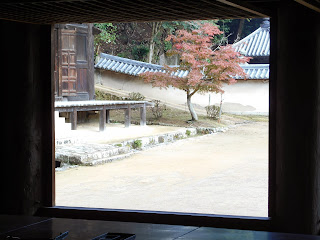I visited Mt. Shosha over the three-day-weekend! It was quite a climb; thankfully there were walking sticks you could borrow for free at the bottom. It had just stopped raining a few hours before, so everything was still very misty and very slippery. I took tons of pictures, but the mist made the lighting tricky, so not too many of them came out. My camera skills are improving, but it's a definite work in progress!
At the start of the trip, at the base of the mountain, a man let us into his backyard to see his traditional Japanese Garden. This was a moss garden; the green stuff on the ground isn't grass, it's moss.
At the start of the trip, at the base of the mountain, a man let us into his backyard to see his traditional Japanese Garden. This was a moss garden; the green stuff on the ground isn't grass, it's moss.
The garden was so beautiful, it was hard to believe it was just his backyard.
It was a work of art, in my opinion!
Here's a shot of the trail up the mountain, probably the easiest part of it. It was mostly dominated by precarious switchbacks with rocky paths, that were, of course, slippery from the rain.
Once you got to the top of the mountain you could notice how the trees were starting to put on their autumn colors. The top of Mt. Shosha is home to about 33 temples, most of which were built around 1,000 years ago. Many Buddhist monks still live, train, and study up here, as they have for the last millennium.
The main path of Mt. Shosha was lined with replicas of the Buddha statues at the heart of the 33 temples. This meant there were 33 miniatures to photograph, which ended up feeling rather like a scavenger hunt. These were a few of my favorites of the photos I took!
Can you spot the "Free Wi-Fi" sign in the above photo?
This beautiful building is apparently an office building!
This is the main temple on Mt. Shosha; it's the biggest and most spectacular one! It's built on a raised platform, and apparently marks the spot of a sacred Cherry Tree where a living statue was once carved. Only the stump remains of that tree, underneath the foundations of the platform.
This dragon fountain was at the entrance to the temple. You are supposed to purify yourself by rinsing your hands and mouth with the water before entering the temple.
Shortly after this point, as we made our way to the temples that were filmed in The Last Samurai, we were hit with a sudden downpour. We managed to take shelter in a nearby tea house due to the kindness of the women working there, and in the nick of time too, because as soon as we got inside the rain started to really come down!
The above photos were some of the better shots of some smaller temples we went by on the way to the ones from The Last Samurai.
Unfortunately, as to the three temples themselves, very few of my photos came out, due to the rain and mist. Maybe, though, some of you will still recognize the last of these photos from the movie! I started tinkering with my camera presets right before my battery died (which I think I might acquire a second battery for, considering its tendency to die after my first few hundred photos). I definitely plan to go back to Mt. Shosha again, it's simply too stunning a place not to!





























Stunning!
ReplyDelete